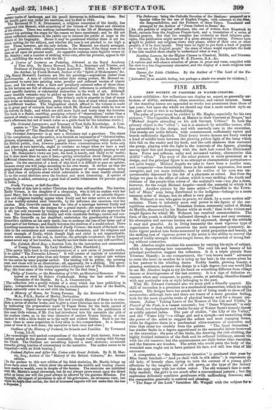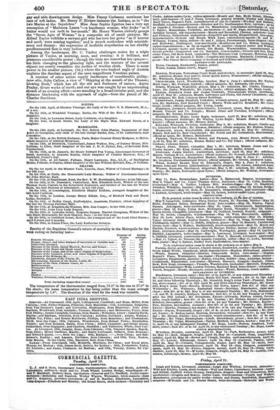FINE ARTS.
NEW SOCIETY OP PAINTERS IN WATER-COLOURS.
A Goon exhibition: few collections can display an aspect so generally un- broken, of ability, animation, clean execution, and varied interest. Soma of the standing names are appended to works less prominent than those of last year; but upon the whole we should say that a more modest style on the part of one or two is no backsliding.
The palm of power must be yielded to Mr. Haghe; especially for his two pictures„" The Capuchin Monks at Matins in their donvent at Bruges," and "
Michael Angelo attending on his sick Servant, Urbino." In both the primary object is the " effect "; but it is attained by artistlike means, with duo painstaking in the design, and with masterly care in the execution. The monks are noble fellows, with countenances sufficiently varied and beards sufficiently dignified. Their heavy brown dresses are finely used as a kind of middle term between the glowing yellow light of the lamp which falls full on the reader and his book, and the cold shadows that surround the group, playing with the light in the intervals of the figures, glancing among their feet and deepening with the dark hair round the illuminated faces. Force and softness, unity and animated variety, characterize this skilful " effect." The story of the other picture is more prominent as a design, and the principal figure is an attempt at characteristic portraiture—, not quite happy. Michael Angelo we take to have been a smaller man, and compacter—leas formidably fierce in his natural expression, but more energetic, and yet more irritable; and the outline of his nose was un- questiondbly depressed by the fist of a playmate at school. But from the design we pass to the effect of colour, which is very striking: the depth and richness of the purple-blue velvet of the sculptor's vest—too fine a dress, however, for the rough Michael Angelo—mock the material in which it is painted. Another picture by the same artist—" Chauffoir in the Town- hall of Mons," soup being distributed to the indigent—belongs to a more common order of design; but its effect is very good. Mr. Wehnert is one who gains in power, we think, by a more modest self- restraint. There is infinitely more real power in the figure of the sur- reptitious servant-student, " Sebastian Gomez, commonly called el Mutate de Murillo, discovered by his Master while at work," than in the violent and turgid figures for which Mr. Wehnert has received commendation. The form of the youth is skilfully indicated through a loose and easy costume; his absorption and nervous tension are well expressed, though the attitude is easy and graceful. As in living humanity the most vigorous type of organization is that which preserves the most compacted symmetry, in- finite vigour packed into forms measured by strict proportion and beauty, so the striking test of vigorous power in the artist is the ability to convey the aspect of bodily strength without turgid forms, the expression of strong feel- ing without contortion. Mr. Absolon might emulate his associate by varying his style of subject, which is degenerating into mannerism. The very life and beauty of his principal production suggest the reflection. It is a triple picture from Tristram Shandy: in one compartment, the "nut-brown maid" advances to meet the hero; in another he is tying up her hair • in the centre-piece he is her partner in the whirling dance. Ruddy health, glowing beauty, a pleasing sentiment, animate the design in a high degree: but one would like to see Mr. Absolon begin to try his hand on something different from village dances or drawingrooms of the last century. It is a sign of defective re- sources when any composer, in poetry, music, or painting, identifies himself with any particular mm or style belonging to the past. With Mr. Edward Corbould also we must pick a friendly quarrel. His skill of execution is a premium to a mechanical mannerism, which he might conquer. His designs have too much the air of being made to show off the accessories; although here and there are traces of a more genuine feeling both for the moat exquisite traits of physical beauty and for a deeper sen- timent. Julian " Taking Leave of the Hostess of the Cat and Fiddle," in Peveril of the Peak, is a vacant coxcomb; but " Dame Whitecraft " is only too ideal, too voluptuous and tender for any of Walter Scott's homely dames or coldly painted ladies. The pair of studies, " the Lily of the Valley," and the "Water Lily "—a village girl and a nymph—are tantalizing from the power of the artist to suggest the softest and most engaging forms, while he disguises them in a mechanical ultra-neatness of execution and tints that shine too crudely from the palette. " The Good Samaritan " has similar faults in a degree apportioned to the successful labour bestowed on the execution: the pose of the limbs, the drawing, the rich clothing, the highly finished imitation of the flesh and its softened brilliancy, almost vie with the old masters; but the countenances are little better than vacuities, and the features are wooden. The artist who could paint the body of the wounded man ought not to have painted his face, and still less that of his' succourer. A companion to " the Momentous Question " is produced this year by Miss Sarah Setchell—" And ye shall walk in silk attire " : it represents an old lady, of homely class, trying to turn the current of a young girl's affections by the tangible aid of a silk gown, as the type of the luxury that she may enjoy with her richer suitor. The old woman's face is care- fally studied; the girl's is too much after a conventional pattern; the expression delicately combines gentleness with unflinching firmess; an the composition generally is natural and pleasing. " The Rape of the Lock " furnishes Mr. Weigall with the subject for it- gay and able drawingroom design. Miss Fanny Corbeanx continues her race of soft ladies. Mr. Henry P. Riviere imitates the Italians, as in " the two Marks at the Sepulchre." Miss Jane Sophia Egerton has a very apt conception of " Madonna Laura "-a handsome woman, whclooks " as if butter would not melt in her month." Mr. Henry Warren cleverly groups the "Seven Ages of Woman" in a composite set of small pictures. Mr. Alfred Taylor exhibits a servant-girl who has torn her gown "as if heaven and earth were coming together," and is struck motionless with astonish- ment and dismay: the expression of ineffable stupefaction on her chubby goodhumoured face is very ludicrous. Among the landscapes, Mr. C. Vacher challenges notice for a triple picture of Venice, at morning, noon, and evening: it is brilliant, and possesses considerable power ; though the tints are somewhat too opaque- too little changing to the glancing light, and the texture of the several objects too nearly resembles the surface of woollen cloth. There is more power in his smaller picture, (32,) where the two-beaked eagle of Austria explains the desolate aspect of the once magnificent Venetian palace. A number of other artists supply landscapes of considerable ability: inter edict' John Callow, a view of " Shipping at the mouth of the Thames; blowing fresh," which has all the stir and freshness of nature; Aaron Penley, divers works of merit; and our eye was caught by an unpretending sketch of an evening effect-cows standing in a broad circular pool, and the distance blackening with the approach of night-from the pencil of Mr. Charles Davidson.



























 Previous page
Previous page